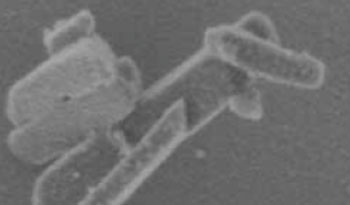Novel Magnetic Resonance System Rapidly Determines Malaria Parasite Load
By LabMedica International staff writers
Posted on 08 Sep 2014
A novel diagnostic technique based on magnetic resonance relaxometry (MRR) was able to rapidly and accurately determine severity of malaria infection without using chemical or immunolabeling.Posted on 08 Sep 2014
When malaria parasites grow within host red blood cells they metabolize large amounts of hemoglobin and convert it into hemozoin crystallites. These hemozoin particles possess relatively large paramagnetic susceptibility, which induces substantial changes in the transverse relaxation rate of proton nuclear magnetic resonance of infected red blood cells. The relaxation rate is a measure of how the nuclear magnetic resonance of hydrogen atoms is affected by the proximity of other magnetic particles – in this case hemozoin.

Image: Electron micrograph (x 68,490) of crystals of hemozoin isolated from the malaria parasite Plasmodium falciparum (Photo courtesy of Wikimedia Commons).
Researchers at the Massachusetts Institute of Technology (Cambridge, USA) and colleagues at Nanyang Technical University (Singapore) prepared a benchtop size MRI instrument around a 0.5-Tesla magnet, which was less expensive and powerful than the 2- or 3-Tesla magnets typically required for MRI diagnostic imaging. They used this instrument to determine numbers of Plasmodium falicparum parasites growing in vitro and Plasmodium berghei parasites taken from infected mice. Blood samples of 10 microliters or less were concentrated by centrifugation and then analyzed without further preparation or labeling.
Results revealed that a parasitemia level of fewer than ten parasites per microliter in a volume below 10 microliters of whole blood was detected in a few minutes for cultured Plasmodium falciparum parasites and in vivo with Plasmodium berghei-infected mice.
"Hemozoin crystals are produced in all four stages of malaria infection, including the earliest stages, and are generated by all known species of the Plasmodium parasite," said senior author Dr. Jongyoon Han, professor of electrical engineering and biological engineering at the Massachusetts Institute of Technology. "Also, the amount of hemozoin can reveal how severe the infection is, or whether it is responding to treatment. There are a lot of scenarios where you want to see the number, rather than a yes or no answer. There is real potential to make this into a field-deployable system, especially since you do not need any kind of labels or dye. It is based on a naturally occurring biomarker that does not require any biochemical processing of samples."
A paper describing the technique was published in the August 31, 2014, online edition of the journal Nature Medicine.
Related Links:
Massachusetts Institute of Technology
Nanyang Technical University













